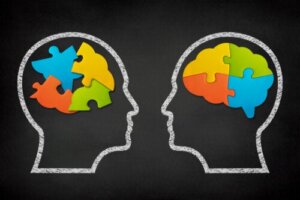The Differences Between ADHD and Autism


Written and verified by the psychologist Maria Fátima Seppi Vinuales
Arriving at a diagnosis of autism or ADHD can be very difficult. First of all, because it requires a thorough behavioral examination, which is very complex, especially in the case of children. For this reason, it’s important to observe them in different situations and contexts over time. Second, because many symptoms and signs coincide between both disorders, having an unequivocal answer right off the bat is complicated. With that in mind, let’s look at some of the differences between ADHD and autism.
What is ADHD
Attention Deficit Disorder, with or without hyperactivity (ADHD), is a neurodevelopmental condition characterized by a deficit in executive brain functions. That is, those that allow organization, attention, concentration, planning, and impulse control, among others.
Children with ADHD may show some behaviors such as the following:
- Difficulty finishing a task.
- Poor time management.
- Extreme restlessness.
- Frequent forgetfulness.
- They perform impulsive actions.
- Difficulty focusing attention.
- A lack of self-control.
You may be interested in: 6 Apps for Children with ADHD

What is autism
Autism spectrum disorders (ASD) refer to a set of neurodevelopmental conditions that are expressed through difficulties regarding language and communication, social skills, and thinking. Also, children with ASD often have stereotyped behaviors and restricted interests.
Know the main differences between ADHD and autism
Although they may have some common characteristics, they’re two different developmental conditions. However, they often occur simultaneously (called comorbidity).
Here are the main differences. Keep reading!
Language difficulties
In autism spectrum disorders, people may have disorders regarding language development, both comprehensive and expressive, and regarding social communication. Many of these children are able to verbalize some ideas or needs but don’t always have the skills to engage in fluent communication with others. This isn’t characteristic or typical of ADHD.
Stereotypies
Children with ASD often maintain some repetitive movements, or “stims”, which can range from flapping their hands to tapping their feet. While children with ADHD are very hyperkinetic, they don’t usually have stereotypies.
Behavioral crises
Disruptive behavioral crises are often caused by the difficulties in processing sensory stimuli that many young children with ASD have. For example, those with auditory hypersensitivity may become overwhelmed at a birthday party.
In contrast, children with ADHD tend to experience more frequent outbursts, usually related to frustration and the inability to control impulses and not with visual, auditory, or tactile stimuli in the environment.
Deficits in social skills
While both conditions present difficulties regarding social skills, children with autism may not know how to interact with others. They’re not able to interpret their intentions or anticipate them, which ultimately limits their ability to relate to peers. In addition, these young children often avoid eye contact, and this further interferes with communication exchange.
Children with ADHD have limitations related to impulsivity. Sometimes they do or say things without thinking due to a lack of impulse control, and end up invading other people’s personal space. However, they’re able to initiate an interaction and hold a conversation.
Flexibility toward change
Children with ASD are disturbed by changes in their routine and are very inflexible when faced with new suggestions.
In contrast, children with ADHD find it difficult to adopt certain routines and sustain them, due to problems in planning and impulse control.
Perseverance
A child with ADHD has serious difficulties when it comes to starting and finishing an activity, while someone with autism is almost obsessively dedicated to meeting their goals.

Two central points that mark the difference between ADHD and autism
In summary, as pointed out in a research study, ADHD and autism have many differences and convergences. Regarding the former, there are two central points where the focus of attention lies:
- When analyzing the executive functions separately (in their different components), experts suggest that people with ADHD will show difficulties in inhibition. On the other hand, those with ASD will show difficulties in planning and flexibility.
- The main differences are explained through “theory of mind”, which is the ability to attribute or interpret the intentions or thoughts of others without the use of words. Children with ASD experience greater difficulties in “reading the minds” of others and show a primary deficit in social orientation, an aspect that is preserved in infants with ADHD.
You may be interested in: Activities for Children with Autism
Accurate diagnoses and adequate aids
For a correct intervention, arriving at the correct diagnosis in time is key. It’s important to be able to determine what’s wrong with the child based on what they express, their behaviors, and what teachers, parents, and professionals can observe.
If you have a feeling that something isn’t going as expected, the best thing to do is to consult with experts as soon as possible. Only then can we provide the most appropriate care.
For example, when a child has undiagnosed ADHD, they’re often labeled as ill-mannered or misbehaving. For this reason, a stigma is created about someone who has a disorder and who needs another type of help.
In this regard, it’s important to evaluate children with their own uniqueness, characteristics, and signs in mind, also taking into account the conditions in their environment.
Arriving at a diagnosis of autism or ADHD can be very difficult. First of all, because it requires a thorough behavioral examination, which is very complex, especially in the case of children. For this reason, it’s important to observe them in different situations and contexts over time. Second, because many symptoms and signs coincide between both disorders, having an unequivocal answer right off the bat is complicated. With that in mind, let’s look at some of the differences between ADHD and autism.
What is ADHD
Attention Deficit Disorder, with or without hyperactivity (ADHD), is a neurodevelopmental condition characterized by a deficit in executive brain functions. That is, those that allow organization, attention, concentration, planning, and impulse control, among others.
Children with ADHD may show some behaviors such as the following:
- Difficulty finishing a task.
- Poor time management.
- Extreme restlessness.
- Frequent forgetfulness.
- They perform impulsive actions.
- Difficulty focusing attention.
- A lack of self-control.
You may be interested in: 6 Apps for Children with ADHD

What is autism
Autism spectrum disorders (ASD) refer to a set of neurodevelopmental conditions that are expressed through difficulties regarding language and communication, social skills, and thinking. Also, children with ASD often have stereotyped behaviors and restricted interests.
Know the main differences between ADHD and autism
Although they may have some common characteristics, they’re two different developmental conditions. However, they often occur simultaneously (called comorbidity).
Here are the main differences. Keep reading!
Language difficulties
In autism spectrum disorders, people may have disorders regarding language development, both comprehensive and expressive, and regarding social communication. Many of these children are able to verbalize some ideas or needs but don’t always have the skills to engage in fluent communication with others. This isn’t characteristic or typical of ADHD.
Stereotypies
Children with ASD often maintain some repetitive movements, or “stims”, which can range from flapping their hands to tapping their feet. While children with ADHD are very hyperkinetic, they don’t usually have stereotypies.
Behavioral crises
Disruptive behavioral crises are often caused by the difficulties in processing sensory stimuli that many young children with ASD have. For example, those with auditory hypersensitivity may become overwhelmed at a birthday party.
In contrast, children with ADHD tend to experience more frequent outbursts, usually related to frustration and the inability to control impulses and not with visual, auditory, or tactile stimuli in the environment.
Deficits in social skills
While both conditions present difficulties regarding social skills, children with autism may not know how to interact with others. They’re not able to interpret their intentions or anticipate them, which ultimately limits their ability to relate to peers. In addition, these young children often avoid eye contact, and this further interferes with communication exchange.
Children with ADHD have limitations related to impulsivity. Sometimes they do or say things without thinking due to a lack of impulse control, and end up invading other people’s personal space. However, they’re able to initiate an interaction and hold a conversation.
Flexibility toward change
Children with ASD are disturbed by changes in their routine and are very inflexible when faced with new suggestions.
In contrast, children with ADHD find it difficult to adopt certain routines and sustain them, due to problems in planning and impulse control.
Perseverance
A child with ADHD has serious difficulties when it comes to starting and finishing an activity, while someone with autism is almost obsessively dedicated to meeting their goals.

Two central points that mark the difference between ADHD and autism
In summary, as pointed out in a research study, ADHD and autism have many differences and convergences. Regarding the former, there are two central points where the focus of attention lies:
- When analyzing the executive functions separately (in their different components), experts suggest that people with ADHD will show difficulties in inhibition. On the other hand, those with ASD will show difficulties in planning and flexibility.
- The main differences are explained through “theory of mind”, which is the ability to attribute or interpret the intentions or thoughts of others without the use of words. Children with ASD experience greater difficulties in “reading the minds” of others and show a primary deficit in social orientation, an aspect that is preserved in infants with ADHD.
You may be interested in: Activities for Children with Autism
Accurate diagnoses and adequate aids
For a correct intervention, arriving at the correct diagnosis in time is key. It’s important to be able to determine what’s wrong with the child based on what they express, their behaviors, and what teachers, parents, and professionals can observe.
If you have a feeling that something isn’t going as expected, the best thing to do is to consult with experts as soon as possible. Only then can we provide the most appropriate care.
For example, when a child has undiagnosed ADHD, they’re often labeled as ill-mannered or misbehaving. For this reason, a stigma is created about someone who has a disorder and who needs another type of help.
In this regard, it’s important to evaluate children with their own uniqueness, characteristics, and signs in mind, also taking into account the conditions in their environment.
All cited sources were thoroughly reviewed by our team to ensure their quality, reliability, currency, and validity. The bibliography of this article was considered reliable and of academic or scientific accuracy.
- Rico-Moreno, Jennifer, & Tárraga-Mínguez, Raúl. (2016). Comorbilidad de TEA y TDAH: revisión sistemática de los avances en investigación. Anales de Psicología, 32(3), 810-819. https://dx.doi.org/10.6018/analesps.32.3.217031
- Proal, E., Olvera, J. G., Blancas, Á. S., Chalita, P. J., & Castellanos, F. X. (2013). Neurobiología del autismo y TDAH mediante técnicas de neuroimagen: divergencias y convergencias. Revista de neurología, 57(0 1), S163.
- Miranda-Casas A, Baixauli-Fortea I, Colomer-Diago C, Roselló-Miranda B. Autismo y trastorno por déficit de atención/hiperactividad: convergencias y divergencias en el funcionamiento ejecutivo y la
teoría de la mente. Rev Neurol 2013; 57 (Supl 1): S177-84.
This text is provided for informational purposes only and does not replace consultation with a professional. If in doubt, consult your specialist.








